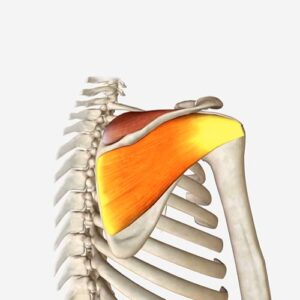A rotator cuff is a group of four small muscles within the shoulder. Which originated from the scapula and detached from the humerus to the humerus to provide dynamic stability at the Glenohumeral (Shoulder) Joint.



These muscles are found deep within the shoulder. So, the pectoralis major, deltoid, trapezius, and latissimus dorsi muscle are some of the large muscles involved in moving our shoulder.




Underneath these, we can find the rotator cuff muscles. So, our shoulder joint is made up of the head of the humerus. Which sits within the shallow glenoid fossa. At any one time, there was only about one-third of that humeral head sitting in the glenoid fossa.



This configuration allows lots of mobility of the joint but in return the shoulder joint sacrifices stability.
To regain stability we have four rotator cuff muscles, which are:
- Supraspinatus
- Infraspinatus
- Teres minor
- Subscapularis
Supraspinatus:
The supraspinatus originates any supraspinous fossa. As with many anatomical terms, the name of the muscle “Supra” refers to above and “Spinous” refers to the spine of the scapula.

So the supraspinatus sits in the supraspinous fossa above the spine of the scapula.

The supraspinatus then passes underneath the acromion to attach to the greater tuberosity on its superior facet.

In terms of its action, the supraspinatus muscle in isolation creates abduction of the humerus. The muscle is innervated by this suprascapular nerve.
Infraspinatus:
The infraspinatus so from its name we can tell that it’s located below the spine of the scapula and it sits within the infraspinous fossa.


The infraspinatus muscle inserts onto the greater tuberosity of the humerus on its middle facet. Just below the insertion of the supraspinatus muscle.

In isolation, the infraspinatus muscle performs lateral rotation or external rotation of the humerus.
It’s worth noting that the supraspinatus and infraspinatus share supply derived from the suprascapular nerve, which comes off the superior trunk of the brachial plexus to supply both of these muscles.

Teres Minor Muscle:
The teres minor muscle is located just inferior to the infraspinatus on the lateral border of the scapula. It then inserts onto the greater tuberosity of the humerus on its inferior facet.


In isolation, the teres minor muscle performs external or lateral rotation of the humerus. The nerve supply to the teres minor muscle is derived from the axillary nerve.
Subscapularis:
The Subscapularis muscle sits on the anterior surface of the scapula. The subscapularis originates in the subscapular fossa, which is this depression occupying almost all of the anterior part of the scapula from its origin on the scapula the subscapularis muscle inserts onto the lesser tuberosity of the humerus.



The subscapularis is the largest and strongest rotator cuff muscle accounting for approximately 50% of the cuff strength output.
When you isolate this muscle it performs medial or internal rotation of the humerus.
The subscapularis is innervated by the subscapular nerves, which are comprised of the upper subscapular nerve and the lower subscapular nerve. Both these nerves originate from the posterior cord of the brachial plexus.
So, that’s an overview of the basic anatomy of the rotator cuff muscles.
For more information talk to a healthcare provider.
If you have any questions about Rotator Cuff, please feel free and leave a comment.
Do share this blog with your friends and family!





